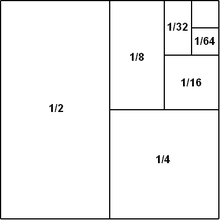1/2 + 1/4 + 1/8 + 1/16 + ⋯

First six summands drawn as portions of a square.

The geometric series on the real line.
In mathematics, the infinite series 1/2 + 1/4 + 1/8 + 1/16 + · · · is an elementary example of a geometric series that converges absolutely.
Its sum is
Direct proof
As with any infinite series, the infinite sum
is defined to mean the limit of the sum of the first n terms
as n approaches infinity. Multiplying sn by 2 reveals a useful relationship:
Subtracting sn from both sides,
As n approaches infinity, sn tends to 1.
History
This series was used as a representation of one of Zeno's paradoxes.[1] The parts of the Eye of Horus were once thought to represent the first six summands of the series.[2]
See also
References
- ↑ Wachsmuth, Bet G. "Description of Zeno's paradoxes". Archived from the original on 2015-12-31. Retrieved 2014-12-29.
- ↑ Stewart, Ian (2009). Professor Stewart's Hoard of Mathematical Treasures. Profile Books. pp. 76–80. ISBN 978 1 84668 292 6.
This article is issued from Wikipedia - version of the 11/6/2016. The text is available under the Creative Commons Attribution/Share Alike but additional terms may apply for the media files.
